 |


|
|
Interview by Jack Nichols
Ralph Bolton and his comrade and lover, Robert Frost, have—bypassing these revisionists— rescued a little-known genius, Witter Bynner, from his brush with oblivion caused when Bynner—early in this century— took part in a hoax cleverly mocking the poetry establishment of his time. Bynner had himself been President of the Poetry Society of America (1920-1922). The establishment did not take kindly, however, to those who dared to thumb their noses at its now-dissolved pretensions. Bynner's lyric works, following the hoax, got little notice. The author of 20 volumes of poetry, Bynner initially came to my attention through his amazing rendering of 2,500 year-old verse titled: The Way of Life According to Lao Tzu. Lao Tzu, a legendary Chinese sage, was, in old age, reputed to have grown weary of mismanagement in the province where he lived. The legends tell how he mounted a water buffalo and rode off into the desert. Before he was allowed to leave, however, a gatekeeper stopped him at the outskirts of the city insisting Lao Tzu leave a record of his timeless wisdom. In 1969, just prior to the Stonewall uprising, I counted myself fortunate at discovering Bynner's translation of Lao Tzu. It quickly became one of three books—including Whitman's Leaves of Grass and Kahlil Gibran's The Prophet--that Lige Clarke and I proffered through the years as gifts to our closest friends. Having decided already that Walt Whitman should be recognized as the fountainhead of our emerging gay and lesbian culture, Clarke and I noted how Witter Bynner had, in his introduction to Lao Tzu, evoked Whitman's approach to life, indicating that the American poet and the ancient Chinese sage were, in effect, spiritual cousins. As we studied Bynner's renderings, the unplanned connection between these muses became—without doubt-- crystal clear. Ralph Bolton, a college professor, and Robert Frost, a former hotel management company executive, had never heard of Witter Bynner when they moved to Santa Fe, New Mexico. Shown a pamphlet about the history of Bynner's house which mentioned the poet's homosexuality as well as his extraordinary literary and artistic connections, they intuited that this site was of major significance for New Mexican and American gay history. They then purchased and restored Bynner's home to its former glory. Today, Bolton and Frost play hosts to travelers at an exquisite bed and breakfast, the Inn of the Turquoise Bear, the name they've given to Bynner's long-time home.
After more than 30 years of neglect, the beautiful adobe villa was in danger of reverting to a pile of mud and the once-spectacular gardens had turned into a jungle of weeds. Having invested three years of very hard work, it was gratifying to have the city express its appreciation for having saved this estate, considered one of Santa Fe's most important historical sites. It is really exciting to share the beauty, the romance, the tranquility and the history of this magical place with our gay and lesbian guests. We find that many of them become enchanted with the spirit of this home.
Jack Nichols: You feel, as I do, a special affinity for Witter Bynner. Having read his biography—Who Is Witter Bynner?—by James Kraft (University of New Mexico Press) I've come to feel like he's a family member—a spiritual relative-- one I truly admire. Is that how you feel? Why is Bynner so important to our gay and lesbian traditions? Ralph Bolton: As we learn more and more about Bynner—and Kraft's biography is indeed a good starting point—our respect and admiration for this man and his life grows. And so does our appreciation of his importance to the gay and lesbian community. He lived a relatively open gay life when doing so was uncommon, not just in New Mexico but anywhere in America. He died in 1968, one year before Stonewall, but he lived a liberated life that can still serve as a model. Although not a gay activist, he was deeply engaged in related causes in the struggle for freedom---in the suffrage movement, in the defense of the rights of Native Americans. He even ran for political office—and lost. But in addition to his serious side, he was forever playful. He had a tremendous sense of humor and a camp sensibility. He was a notorious figure in Santa Fe, appearing at times in long Chinese robes or Native American garb. He was gregarious and took a deep interest in his countless friends, and in this, too, he was the quintessential gay man, creating a "family of choice" in his circle of friends. I think there is an unfortunate tendency in the gay and lesbian community to ignore, and even vilify, the gay men and lesbians of earlier generations for their perceived failures to create an effective liberation movement. But men such as Bynner, products of their time not ours, really paved the way. Because he was such an engaged and respected citizen and because he lived an openly gay life, Bynner contributed enormously to the climate of tolerance and acceptance of sexual diversity which characterizes Santa Fe today. Jack Nichols: Who have been some of the notable literary, philosophic and artistic personalities that Witter Bynner knew and hosted in the Inn of the Turqoise Bear? He was friendly with the philosopher Santayana, I know, and socialized with Robert Frost too, right? And he almost married Edna St. Vincent Millay.
Ralph Bolton: The list of Bynner's famous friends reads like a who's who of the world in the first half of the 20th Century, and he and his partner, Robert Hunt, entertained many of these celebrities in this home. D. H. Lawrence spent his first and last nights in an American home as Bynner's guest---and, indeed, a little known fact is that Lawrence's remains are on this estate, but that's a long story which I reserve for another time. A recitation of the names of famous friends and guests would have to include not only Frost and Millay, but Carl Sandburg, Igor Stravinsky, Aldous Huxley, Georgia O'Keeffe, Cecil B. DeMille, Clara Bow, Christopher Isherwood, Ezra Pound, Henry James, Martha Graham, Willa Cather, Ansel Adams, Oliver LaFarge, Mary Austin, Mark Twain, Stephen Spender, Vachel Lindsay, Isadora Duncan, Paul Burlin, Paul Horgan, Carl Van Vechten, John Dewey, O. Henry, Lynn Riggs, Wallace Stevens, Frida Kahlo, Diego Rivera….really the list is endless. And most of these people were entertained in this house. We are in the process of seeking out information on other people whom we suspect knew Bynner, such as Tennessee Williams. Jack Nichols: Bynner greatly admired Walt Whitman. And he actually knew Kahlil Gibran. Somehow, I feel, my early choices of Whitman, Lao Tzu and Gibran--making them my mentors gets vindicated through Bynner. They all dovetail, as I'd long thought, and Bynner in real life appears to have demonstrated this fact. Can you understand why I see Bynner as having validated my attraction to these literary giants? Ralph Bolton: Oh, yes, absolutely. Bynner is a lynchpin that brings together your mentors—Whitman, Lao Tzu and Gibran. There is a spiritual and philosophical connection among these great writers that spans the many centuries separating their lives. Indeed, given the affinity between Whitman and Bynner, it's interesting to note that there is a myth that Bynner was actually Whitman's illegitimate son…and another myth that Bynner had African-American ancestors because of his interest in African-American poets and writers such as Countee Cullen and Langston Hughes and his attitudes on race. As for Gibran, you might be interested to know that a portrait of Bynner by Gibran appears in the book of verse entitled "The New World." Jack Nichols: How, in his personal life, do you think Bynner showed attitudes similar to Whitman's—or to Lao Tzu's, for that matter.
But while Bynner's poetry may not have achieved the greatness of Whitman's, Bynner's life was in some ways more exemplary. Whitman, for instance, publicly denied the homosexual aspect of his work and thought—though this was obvious to everyone. Bynner, on the other hand, lived out his homosexuality and openly accepted it. What characterizes all three of these men was a belief in what has been called "creative quietism," the idea that action can be emptier than inaction and that the way to do was to be. They all believed that life could be useful, peaceful and happy. Contemporary gay men and women might learn something from this. I note that Urvashi Vaid was recently quoted as saying about gay life, "Every gay person I know boasts about working 15-hour days….Manic activity without meaning and without end. What happened to sloth?" Echoes of Lao Tsu, Whitman, and Bynner! Jack Nichols: Wouldn't you like to see—as I would—Bynner's name popping up whenever we talk of W.H. Auden, Christopher Isherwood, A.E. Houseman, Langston Hughes and gay-identified celebrities like that? Ralph Bolton: (laughing) Yes, of course, Jack. I think Bynner deserves a prominent place in the pantheon of gay heroes. There is so much in his life and work to admire, to learn from, and to emulate. Jack Nichols: Bynner seems to have been simultaneously monogamous and promiscuous. He did have a single lover throughout most of his life. A prominent New Mexico matron accused him, however, of single-handedly bringing homosexuality to New Mexico. This had something to do with the famous or infamous parties he and his lover threw, didn't it? Ralph Bolton: Actually, Bynner (whose friends called him 'Hal') had a series of lovers prior to "settling down" with Robert Hunt for the long haul, when Bynner was 49 years old. Hunt was 25 years his junior. They lived together in this house for 34 years, until Hunt's death.
Thevenaz died at the age of 31 of a ruptured appendix. The loss had a profound impact on Bynner, despite the brevity of their love affair. Jack Nichols: What are some of Bynner's major themes? Ralph Bolton: The major themes of Bynner's work are those of all great literature: love and death, joy and loss. Beyond that, Bynner was preoccupied with the transitory nature of all things, with the lessons to be learned from other cultures---both Asian and Native American in particular, and I've already mentioned his faith in democracy and the common man. But he was also devoted to perversely poking fun at the foibles and pretensions of people he knew. An honest man himself, he delighted in exposing hypocrisy. Jack Nichols: Bynner was a traveler. Though he lived for over four decades in the house where you now reside, he went to other countries. Where? And why? Ralph Bolton: Bynner had traveled to the Orient twice before moving to Santa Fe. And he had a lifelong fascination with the culture of China, for which he had a high regard. Anti-imperialist, he was less enamored of Japan. As you know, Jack, he is probably best known today for his translations of Chinese literature, which influenced his own writing and philosophy. During his first trip to China he had acquired an idealized conception of the country, which was tempered by a subsequent, longer visit in 1920-21. Bynner also made two trips to Europe, meeting with Alice B. Toklas in Paris on the second trip. He was not terribly interested in Europe. Critical of Western Civilization, both European and American, he seemed to feel that he could learn more from Asian and Native American cultures. Bynner and Hunt also spent many winters in Chapala, Mexico where they had purchased a house in 1940. This second home offered an escape from the constant stream of visitors who sought him out in Santa Fe and allowed him more peace and quiet and the opportunity to write undisturbed. His life in Mexico inspired many of his poems. Jack Nichols: What are some of the more outrageous tales you know about Bynner? Ralph Bolton: Ah, outrageous tales? There are so many, and we love recounting them to our guests at breakfast and during the wine & cheese hour we have each evening at the Inn. We keep learning more each day about what these walls would say if they could talk.
Jack Nichols: Bynner once poured a mug of beer on Robert Frosts head, I know, but Frost seemed to forgive him and to honor him, actually, by quoting from memory two Bynner poems. Ralph Bolton: I would have loved to witness this famous incident in which Bynner apparently lost his composure. Frost, who was not particularly lovable in any case, appears to have deliberately provoked Bynner. Both Frost and Bynner had received copies of a manuscript of poems by a young poet, Horatio Colony. Some of the poems had a homoerotic theme. Bynner praised the poems, and Frost baited him about his sexuality. And so the beer was wasted---or maybe not! Their relationship was strained thereafter, but, you're right, many years later during a chance encounter, Frost forgave Bynner, and when Frost died, Bynner wrote a poem in his honor. Jack Nichols: Do you have any favorites among the verses Bynner left us? What are they? Ralph Bolton: I find myself moved by many of Bynner's poems. One of the very best, bound to appeal to the anthropologist in me, is The Rain at Cochiti, which is a magnificent tribute to a Native American culture. But I am also fond of the verses from Against the Cold, especially these:
I am too simple for those lesser ways
Jack Nichols: There's a kind of down-to-earth quality in Bynner. He doesn't seem to have been an ideologue. What would you say to this? Ralph Bolton: Bynner was definitely not an ideologue, although he had some strong views, to be sure. He was a pacifist during World War I, and he was a democratic socialist in leanings and sympathetic to social change. He was a humanist and a cultural relativist.
Jack Nichols: James Kraft, in his biography, quotes a Bynner poem called Epithalamium and Elegy . On page 111, Kraft talks about Bynner's marrying of life itself. What did he mean, do you think? Ralph Bolton: That poem is one of Bynner's best, in my opinion, and it expresses beautifully his philosophy. He wrote that in 1925 around the same time he wrote a poem in memory of Thevenaz, who had died only a few years earlier. Enjoy life…it's all you have; accept the inevitable, death. Live life to the fullest and everything's OK, even death. This is sort of a joyful fatalism. Jack Nichols: Tell me a little about Robert Hunt, Bynner's long time lover. Ralph Bolton: Bob Hunt was the son of a prominent Southern California architect, Myron Hunt, who designed the many public structures including the Rose Bowl and the Huntington Library. He was a dabbler of sorts, a poet, an architect. He never seemed to find anything to devote himself to, except Hal, of course. Apparently he was a handsome man, tall, lean, intelligent, and widely read. From the letters they wrote to each other when separated during World War II, it is clear they loved each other. We wonder about the relationship, something of a Daddy/boy relationship perhaps. But Hunt was the Dionysian contrast to the Apollonian side of Bynner, who never left behind completely his Eastern formality. Notable for his sexual escapades, according to one participant we've talked with, Hunt would go to the plaza or Canyon Road and recruit guys to join in orgies which went on for days in the east wing of the house. He was also said to be responsible for the glory holes in the bathrooms at La Fonda, the hotel on the plaza. He seems to have been a perfect helpmate to Bynner's, editing his work, caring for his home, and providing entertainment and devotion. His death devastated Bynner, who suffered a stroke a year later and then lingered for three more years. Jack Nichols: How do you think it became possible to eliminate Bynner—as almost happened—from history? After all, he was a notable in his time. Ralph Bolton: The combined effect of several factors may have led to the historical amnesia regarding Bynner. First, the poetry establishment did not take kindly to the Spectra hoax he and Arthur Fricke had pulled off---the literary equivalent of Piltdown. Second, he lived in the interior of the continent, far from the intellectual power centers of the country on the East or West Coast…and he wrote about places and peoples of little concern—Native American life, for instance. Third, his homosexuality was common knowledge—and his openness about it perhaps a bit too blatant. Fourth, to some extent, Bynner was less interested in self-promotion than in facilitating the careers of his friends. He was a very generous man. Jack Nichols: You would like—as I would--to spread the knowledge of Bynner and his work far and wide. What are some of the ways others can do this? What are some of the obstacles? Ralph Bolton: Getting the word out about Bynner is a high priority for us. We believe gay men and women have much to learn from him. They can begin by reading the biography by James Kraft, Who Is Witter Bynner?, and the volume of selected works by Bynner, edited also by Kraft. We have purchased large quantities of both volumes from the publisher and readers can purchase copies by calling the Inn at 1-800-396-4104. Articles about Bynner and the Inn have begun to appear in general publications such as New Mexico Magazine, and The Santa Fean has an article in preparation. Beyond that, eventually we would like to set up a website devoted to Bynner and make some of his work available online to a wider audience. We are also interested in having occasional symposia at the Inn to bring together scholars and others who wish to explore Bynner's life and works in greater depth. We need to find funding for these endeavors. Above all, we would love to hear from people who knew Bynner. We have been most fortunate in hearing from some people who knew him, and they have provided us with letters and photos which add immensely to our knowledge and which we share with our guests at the Inn. John Meigs even gave us an ancient Chinese vase that belong to Bynner and that has now been restored to its place in the house where Bynner kept it. The on-going work of preservation is truly exciting. Jack Nichols: Why do you think Bynner chose Santa Fe to live—after having traveled around the world?
He found New Mexico exotic, unique, and, perhaps above all, tolerant. It was here that he could live freely, away from family and Eastern codes of conduct. He'd taught at Berkeley briefly, and quite successfully, but he wanted to devote himself to writing. Santa Fe was as good a place as any for that, and perhaps cheaper, too, in those days. He had independent means and could live here in a mud hut for very little. And, last but not least, he was intrigued by Native American cultures and the complex history of this region. Jack Nichols: I want to congratulate you both for rescuing a hero. I hope someday soon to be able to visit the Inn of the Turquoise Bear. I've yet to make it to Whitman's house in Camden, but both spots are on my itinerary of dreams. Ralph Bolton: Jack, we look forward to your visit to the Witter Bynner Estate and the Inn of the Turquoise Bear. We know you will enjoy the spirit of this place. To order books about Witter Bynner or to Make Reservations in Santa Fe at The Inn of the Turquoise Bear Toll-free number : 1-800-396-4104 |

© 1997-99 BEI
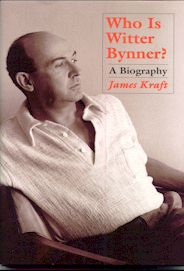 History's revisionists, a numerous lot, too often leave
great thinkers, poets and artists—especially those
in the gay and lesbian traditions—in the dust.
History's revisionists, a numerous lot, too often leave
great thinkers, poets and artists—especially those
in the gay and lesbian traditions—in the dust.
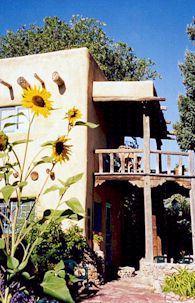 Inn of the Turquoise Bear
Inn of the Turquoise Bear 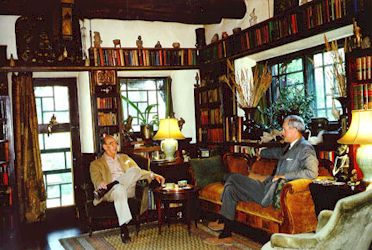 Witter Bynner (left) talking with an unidentified man in his library, which is now the Inn's living room
Witter Bynner (left) talking with an unidentified man in his library, which is now the Inn's living room
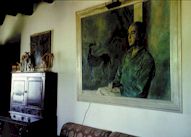 Portrait of Bynner, painted by his friend, Henriette Hurd Wyeth,
hanging in his study
Portrait of Bynner, painted by his friend, Henriette Hurd Wyeth,
hanging in his study 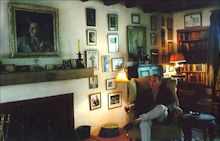 Seated is Robert Hunt, Bynner's lover of 34 years, with a portrait of
Hunt above the mantle piece, also by Henriette Hurd Wyeth. The room is now the Shaman guest room, but was originally Bynner's "outside studio"
Seated is Robert Hunt, Bynner's lover of 34 years, with a portrait of
Hunt above the mantle piece, also by Henriette Hurd Wyeth. The room is now the Shaman guest room, but was originally Bynner's "outside studio" 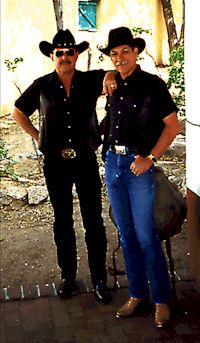 Ralph Bolton (left) and Robert Frost
Ralph Bolton (left) and Robert Frost
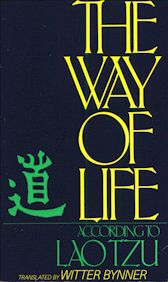 I think we can understand him by returning to Lao Tzu and the opening lines of The Way of Life: "Existence is beyond the power of words to define, Terms may be used, but none of them absolute."
I think we can understand him by returning to Lao Tzu and the opening lines of The Way of Life: "Existence is beyond the power of words to define, Terms may be used, but none of them absolute."
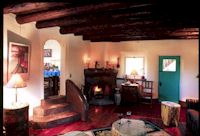 Gathering Room at the Inn of the Turqoise Bear
Gathering Room at the Inn of the Turqoise Bear